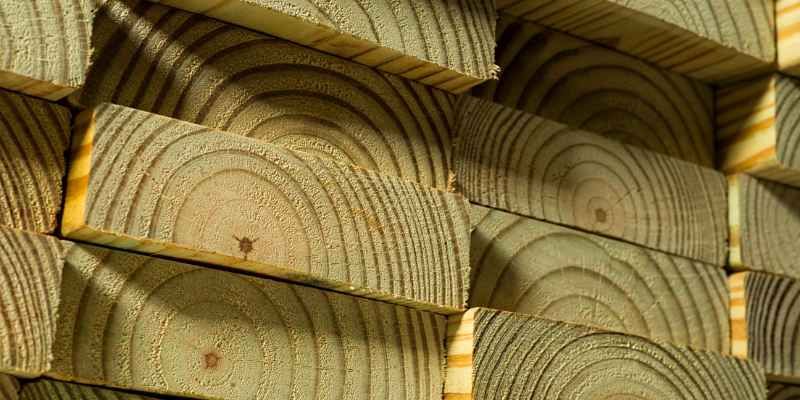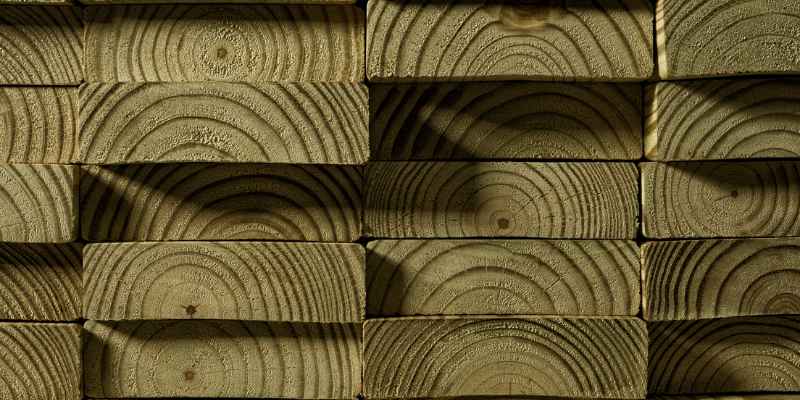To seal cut ends of pressure treated wood, brush, splash, or wipe on any kind of paint, tar, or even melt wax to seal the end grain the instant the wood is cut. This will prevent moisture buildup and potential rotting.
Using a commercial product like Cut-N-Seal or organic solutions like saturated borax and boric acid can also effectively protect the end cuts from moisture damage. Additionally, using a wood preservative or deck stain can provide added protection to the wood and ensure its longevity.
Properly sealing cut ends of pressure treated wood is crucial in maintaining the integrity of the wood, and preventing any potential safety hazards that may arise from weakening or rotting overtime.
Applying The Sealant
When sealing cut ends of pressure treated wood, it’s important to apply the sealant properly. In a helpful DIY video, applying the sealant is highlighted as the most crucial step. Ensuring the edges are covered will help protect the wood and prolong its lifespan.
Make Sure To Cover The Edges
Before applying the sealant, it’s important to ensure that you cover the edges of the cut ends of pressure-treated wood. This will prevent any moisture from getting inside the wood and causing rot. You can use a brush or spray to cover the edges of the wood with the sealant, making sure you get full coverage.
Tools And Materials Needed
To apply the sealant, you’ll need a few tools and materials. These include a brush or spray, a sealant, and possibly a sandpaper. You may also need protective gloves and goggles. The type of sealant you choose should be specifically designed for pressure-treated wood and should be labeled as such.
Step-by-step Process
Here’s a step-by-step process for applying the sealant to the cut ends of pressure-treated wood:
- Clean the cut ends of the wood with a brush or sandpaper, making sure to remove any debris or rough edges.
- Apply the sealant generously to the cut ends of the wood using a brush or spray. Make sure to cover the edges completely.
- Allow the sealant to dry completely according to the manufacturer’s instructions.
- If necessary, apply a second coat of sealant after the first coat has dried completely.
Remember, applying a sealant to the cut ends of pressure-treated wood is an important step in ensuring the longevity and durability of your wood project. By following these steps and using the right tools and materials, you’ll be able to seal the cut ends of pressure-treated wood effectively and efficiently.

Types Of Sealants
To seal cut ends of pressure treated wood, various sealants can be used such as wood preservative, deck stain, and end cut sealer. It is important to apply the sealant carefully covering all the edges to prevent any rotting or damage to the wood.
There are various commercial products available, but borax and boric acid solutions in hot water can also be used for above ground applications.
Sealing cut ends of pressure treated wood is an important step to take to ensure your deck or treated lumber lasts for a long time and stays looking great. There are a few different types of sealants available, each with their own benefits. Let’s take a closer look at some of the most popular options.
Wood Preservative
Wood preservative sealants are highly effective at protecting the cut ends of pressure treated wood from moisture and decay. These sealers penetrate deep into the wood, providing long-lasting protection. Look for products like Woodlife Coppercoat Green Wood Preservative or Copper Green Wood Preservative for an effective wood preservative.
Deck Stain
Deck stain is another popular option for sealing cut ends of pressure treated wood. Not only does it help to prevent moisture damage, but it also provides a beautiful, natural-looking finish. Penofin Transparent Oil-Based Deck Stain is a great option for those looking for a high-quality deck stain.
Seal Once Marine Premium Wood Sealer
Another highly effective sealant is Seal Once Marine Premium Wood Sealer. This product boasts a unique water-based formula that penetrates deep into the wood, providing excellent moisture protection. It’s also highly resistant to UV exposure, making it a great choice for outdoor use.
Cut-N-Seal
Cut-N-Seal is a specialized sealer designed specifically for sealing cut ends of pressure treated wood. This product is easy to use, and provides excellent moisture protection. It’s also resistant to fungi and decay, so you can be confident that your treated wood will last for a long time.
In conclusion, there are several effective sealants available for sealing cut ends of pressure treated wood. Whether you choose a wood preservative, deck stain, Seal Once Marine Premium Wood Sealer, or Cut-N-Seal, it’s important to take the time to properly seal your treated wood to ensure it lasts for years to come.
Alternative Methods For Sealing Cut Ends Of Wood
To seal cut ends of pressure-treated wood, there are several alternative methods. One option is to apply paint, tar, or wax to the end grain immediately after cutting. Other options include using wood sealers or end grain preservers such as Black Jack, Flex Seal, or Ronseal.
It is important to protect the wood from rotting and fungal attacks.
Pressure-treated wood is widely used for outdoor construction projects due to its durability and resistance to insects and fungi. However, when you cut pressure-treated wood, the exposed end grain is vulnerable to moisture damage and decay. To protect your project and extend its lifespan, you should seal the cut ends of the wood. While the most common method is to use a water-repellent preservative, there are alternative methods you can use as well. Let’s take a look at these methods below.
Paint Or Tar
One of the simplest alternative methods of sealing cut ends of wood is to use paint or tar. You can brush or apply any kind of oil-based paint or tar to the end-grain immediately after cutting it. The paint or tar creates a barrier that prevents moisture from penetrating the wood. However, it is worth noting that paint or tar may not be entirely effective in protecting the wood from moisture over the long term.
Melt Wax
Another alternative method to seal cut ends of wood is to melt wax onto the end-grain. You can use a mixture of beeswax and paraffin wax or buy wax sticks specifically designed for this purpose. Simply heat the wax mixture and apply it to the cut end of the wood. The wax hardens quickly, creating a water-resistant seal that serves as a physical barrier against moisture. However, it may not be a permanent solution and may need to be reapplied every few years.
Use Commercial Products Such As ‘bora-care’
Another effective alternative method of sealing cut ends of wood is to use commercial products such as ‘Bora-Care.’ It is a borate-based wood preservative that provides long-term protection against decay, termites, and other wood-damaging pests. Bora-Care can be applied to both green and dry wood and helps stabilize the wood to prevent warping and twisting. However, this method may be expensive compared to other alternatives.
Saturated Solutions Of Borax And/or Boric Acid In Hot Water
Another alternative method of sealing cut ends of wood is to use a solution of borax and/or boric acid in hot water. Mix the borax and boric acid in hot water until they dissolve completely and saturate the end-grain for several minutes. The solution penetrates deep into the wood, providing long-lasting protection against decay and pests. However, it may not be easy to find these chemicals locally, and the solution may need to be reapplied over time.
In conclusion, sealing the cut ends of pressure-treated wood is essential for maintaining the wood’s durability and longevity. While water-repellent preservatives are the go-to method for most people, there are alternative methods available, including paint or tar, melted wax, commercial products such as Bora-Care, and saturated solutions of borax and boric acid in hot water. Choose the method that fits your budget and needs.

Additional Tips For Sealing Cut Ends Of Wood
To effectively seal cut ends of pressure treated wood, it is important to use the right products and techniques. Consider using wood stain, preservatives, or deck sealers to prevent moisture and decay. Make sure to thoroughly cover all edges and reapply as necessary to keep your wood protected.
When it comes to pressure-treated wood, it is important to seal the cut ends to prevent moisture from seeping in. This helps to prevent rot and decay, which can significantly shorten the lifespan of your wood. In this section, we will discuss some additional tips for sealing cut ends of pressure-treated wood, including trimming the end grain to discard the original sealer/paint, recoating with Anchorseal or just recoating over the original seal coat, what kind of sealant to use on pressure-treated wood, and what to treat cut ends of decking with.
Trim the End Grain to Discard Original Sealer/Paint
To ensure a strong seal on your pressure-treated wood, it is important to trim the end grain to discard the original sealer/paint. This allows the new sealant to penetrate the wood and create a strong bond. You can simply use a saw to trim off the end of the wood, making sure to cut straight through the grain.
Recoat with Anchorseal or Just Recoat Over the Original Seal Coat
Another option for sealing cut ends of pressure-treated wood is to recoat with Anchorseal or just recoat over the original seal coat. Anchorseal is a popular brand of sealant that is specifically designed for use on cut ends of wood. If you have already applied a sealant to your wood, you can simply apply a new coat over the top to ensure that the entire cut end is sealed.
What Kind of Sealant to Use on Pressure-Treated Wood?
When it comes to choosing a sealant for your pressure-treated wood, there are several options to consider. Some popular choices include wood stain, deck stain, wood preservative, and treated deck sealant. It is important to choose a product that is specifically designed for use on pressure-treated wood to ensure a strong bond and long-lasting protection.
What Do You Treat Cut Ends of Decking With?
For decking specifically, it is important to use a product that is designed to penetrate deep into the wood and protect it from moisture and decay. One popular option is Ronseal Decking End Grain Preserver, which has a special formula that penetrates deeply to protect cut ends of decking. Other options include wood preservatives and deck sealants designed specifically for use on pressure-treated wood.
Overall, sealing cut ends of pressure-treated wood is an important step in protecting your wood and ensuring long-lasting durability. By following these additional tips, you can ensure that your cut ends are properly sealed and protected from moisture and decay.
Frequently Asked Questions Of How To Seal Cut Ends Of Pressure Treated Wood
Does Pressure-treated Wood Need To Be Sealed After Cutting?
Yes, pressure-treated wood needs to be sealed after cutting. Use any kind of paint, tar, or even melt wax to seal the end grain the moment the log is cut. You can also use commercial products such as Bora-Care or saturated solutions of borax and/or boric acid in hot water.
It’s recommended to use in above ground applications and continuously protected from liquid water. Brush, splash or wipe the sealer to cover the edges. Trim the end and recoat if necessary. Ronseal Decking End Grain Preserver is a good option to prevent rotting and wood fungi attack.
How Do You Seal Cut Ends Of Wood?
To seal cut ends of wood, brush on any kind of paint or tar or even melt wax to seal the end grain the instant the log is cut. Black Jack or Flex Seal are recommended sealants for pressure-treated wood.
Ronseal Decking End Grain Preserver is also useful to prevent rotting and wood fungi attack. Cut-N-Seal® is a water-based brush-on sealer and moisture repellent for cuts and holes in pressure-treated wood.
What Kind Of Sealer To Use On Pressure-treated Wood?
To seal pressure-treated wood, you can use any kind of paint, tar, or wax. However, using a sealant designed specifically for pressure-treated wood is recommended. Commercial products such as Bora-Care or Black Jack can be used, as well as special formulas like Ronseal Decking End Grain Preserver or Cut-N-Seal brush-on sealer.
It is important to apply the sealant to end cuts as soon as possible to prevent the wood from absorbing moisture and rotting.
What Do You Treat Cut Ends Of Decking With?
To treat cut ends of decking, use Ronseal Decking End Grain Preserver or any organic sealant like borax and boric acid solutions to prevent rotting and attack by wood fungi. Brush or wipe the sealant onto the cut ends. Cut-N-Seal is a water-based brush-on sealer and moisture repellent that also works well.
Conclusion
Taking the necessary steps to seal the cut ends of pressure treated wood is crucial in prolonging the lifespan of your structure. Whether you choose to brush on a sealer, apply a wood preservative, or use a decking end grain preserver, treating your end cuts will prevent wood rot and fungal attack.
Don’t take shortcuts when it comes to your pressure treated wood – treat your end cuts properly to ensure a healthy and long-lasting structure.


